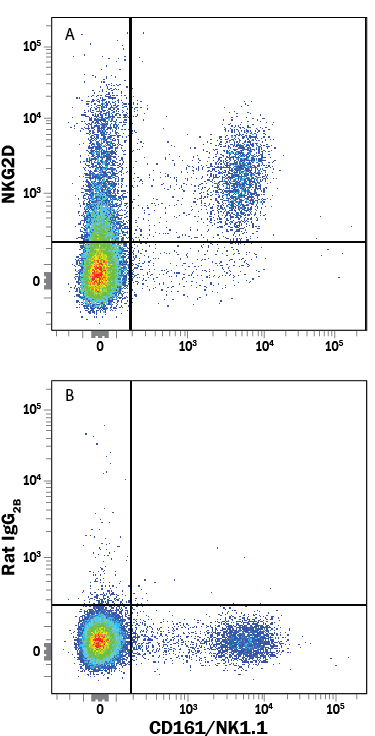Mouse NKG2D/CD314 PE-conjugated Antibody Summary
Phe94-Val232
Accession # O54709
Applications
Please Note: Optimal dilutions should be determined by each laboratory for each application. General Protocols are available in the Technical Information section on our website.
Scientific Data
 View Larger
View Larger
Detection of NKG2D/CD314 in Mouse Splenocytes by Flow Cytometry. Mouse splenocytes were stained with Mouse CD161/NK1.1 APC‑conjugated Antibody (FAB76141A) and either (A) Rat Anti-Mouse NKG2D/CD314 PE-conjugated Monoclonal Antibody (Catalog # FAB1547P) or (B) Rat IgG2BPhycoerythrin Isotype Control (IC013P). View our protocol for Staining Membrane-associated Proteins.
Reconstitution Calculator
Preparation and Storage
- 12 months from date of receipt, 2 to 8 °C as supplied.
Background: NKG2D/CD314
NKG2D, also known as CD314, is a type II transmembrane protein with an extracellular C-type lectin-like domain. It occurs as a disulfide-linked homodimer that associates with the transmembrane DAP10 (DNAX-activator protein 10) adapter protein to deliver an activating signal. This protein shares approximately 25% amino acid sequence identity with a number of other type II lectin-like proteins that are encoded by genes within the natural killer complex on mouse chromosome 6. NKG2D is expressed on NK cells, where it functions as an activating receptor to trigger cytolytic activity and cytokine secretion, and on some T cell subsets, where it acts as a co‑stimulatory receptor complementing T cell receptor signaling. Several ligands have now been identified for mouse NKG2D including H60 and Rae 1 alpha, beta, gamma, δ, and epsilon. All of these ligands are cell-surface proteins distantly related to MHC class I. However, they do not bind peptide or associate with beta 2-microglobulin. Ligand expression is up-regulated in many transformed cell lines and also during conditions of stress such as heat shock or viral infection. In vivo, tumor models demonstrate that NKG2D functions in anti-tumor surveillance (1-5).
- Bauer, S. et al. (1999) Science 285:727.
- Wu, J. et al. (1999) Science 285:730.
- Diefenbach, A. et al. (2001) Nature 413:165.
- Vivier, E. et al. (2002) Curr. Opin. Immunol. 14:306.
- NKG2D and its Ligands; www.RnDSystems.com.
Product Datasheets
Citation for Mouse NKG2D/CD314 PE-conjugated Antibody
R&D Systems personnel manually curate a database that contains references using R&D Systems products. The data collected includes not only links to publications in PubMed, but also provides information about sample types, species, and experimental conditions.
1 Citation: Showing 1 - 1
-
Preferential TNF? signaling via TNFR2 regulates epithelial injury and duct obstruction in experimental biliary atresia
Authors: P Shivakumar, T Mizuochi, R Mourya, S Gutta, L Yang, Z Luo, JA Bezerra
JCI Insight, 2017-03-09;2(5):e88747.
Species: Mouse
Sample Types: Whole Cells
Applications: Flow Cytometry
FAQs
No product specific FAQs exist for this product, however you may
View all Antibody FAQsReviews for Mouse NKG2D/CD314 PE-conjugated Antibody
There are currently no reviews for this product. Be the first to review Mouse NKG2D/CD314 PE-conjugated Antibody and earn rewards!
Have you used Mouse NKG2D/CD314 PE-conjugated Antibody?
Submit a review and receive an Amazon gift card.
$25/€18/£15/$25CAN/¥75 Yuan/¥2500 Yen for a review with an image
$10/€7/£6/$10 CAD/¥70 Yuan/¥1110 Yen for a review without an image



